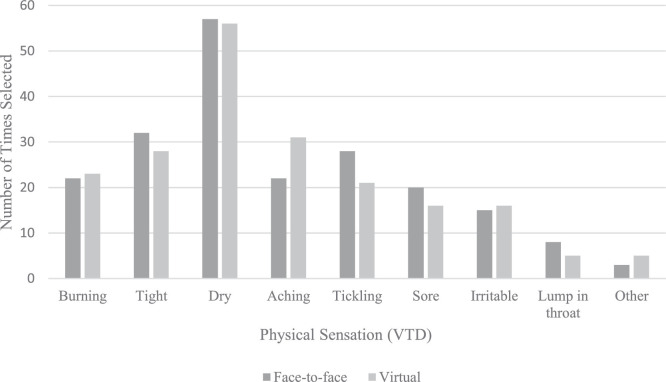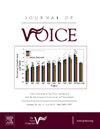虚拟教学对 COVID-19 大流行期间教育工作者声音的影响。
IF 2.4
4区 医学
Q1 AUDIOLOGY & SPEECH-LANGUAGE PATHOLOGY
引用次数: 0
摘要
导言:由于 COVID-19 大流行,美国的专业人员被强制要求在家工作,以保护民众的健康需求。工作环境的改变和人体工程学因素对工作者的声带健康构成了威胁,尤其是对教育工作者等声带负荷较大的职业人群。本研究比较了全职教育工作者在面对面和虚拟环境下的声道不适症状和自我感觉的嗓音障碍。此外,本研究还试图找出特定环境因素与不适程度之间的关系:方法:本研究通过向 223 名全职教育工作者发放在线调查问卷的方式进行了一项横断面研究。该调查收集了关于面对面教学和虚拟教学中声道症状、虚拟工作环境因素、个人嗓音健康习惯以及在各种环境中自我感觉的嗓音障碍的数据:结果:在这一样本人群中,转向虚拟工作环境并没有导致声带不适症状数量的显著增加或嗓音障碍的增加。然而,空气质量和水摄入量等环境因素与声道不适程度的相关性最强:为全职教育工作者提供有关嗓音疾病风险和环境因素对嗓音健康影响的资源是有益的。本文章由计算机程序翻译,如有差异,请以英文原文为准。


Effects of Virtual Instruction on Educators’ Voices During the COVID-19 Pandemic
Introduction
Resulting from the COVID-19 pandemic, professionals in the United States were mandated to work virtually from home to protect the health needs of the population. The shift in setting and ergonomic factors posed a threat to the vocal health of workers, and more specifically, to those whose professions inflict significant vocal load, such as educators. This study compared the symptoms of vocal tract discomfort and self-perceived voice handicap in full-time educators between face-to-face and virtual settings. Additionally, this study sought to identify relationships between specific environmental factors and levels of discomfort.
Methods
A cross-sectional research study was conducted by distributing an online survey to 223 individuals who identified as full-time educators. This survey collected data on vocal tract symptoms during both face-to-face and virtual instruction, environmental factors of virtual work setting, personal vocal health habits, and self-perceived voice handicap in each setting.
Results
In this sample population, the shift to a virtual work setting did not result in a significant increase in the number of vocal discomfort symptoms or an increase in vocal handicap. However, environmental factors such as air quality and water intake had the strongest correlation with levels of vocal tract discomfort.
Conclusion
It is beneficial to provide resources to full-time educators regarding the risk of voice disorders and the impact of environmental factors on vocal health.
求助全文
通过发布文献求助,成功后即可免费获取论文全文。
去求助
来源期刊

Journal of Voice
医学-耳鼻喉科学
CiteScore
4.00
自引率
13.60%
发文量
395
审稿时长
59 days
期刊介绍:
The Journal of Voice is widely regarded as the world''s premiere journal for voice medicine and research. This peer-reviewed publication is listed in Index Medicus and is indexed by the Institute for Scientific Information. The journal contains articles written by experts throughout the world on all topics in voice sciences, voice medicine and surgery, and speech-language pathologists'' management of voice-related problems. The journal includes clinical articles, clinical research, and laboratory research. Members of the Foundation receive the journal as a benefit of membership.
 求助内容:
求助内容: 应助结果提醒方式:
应助结果提醒方式:


